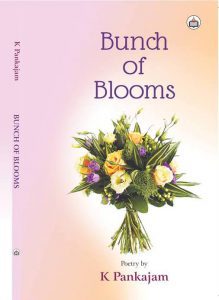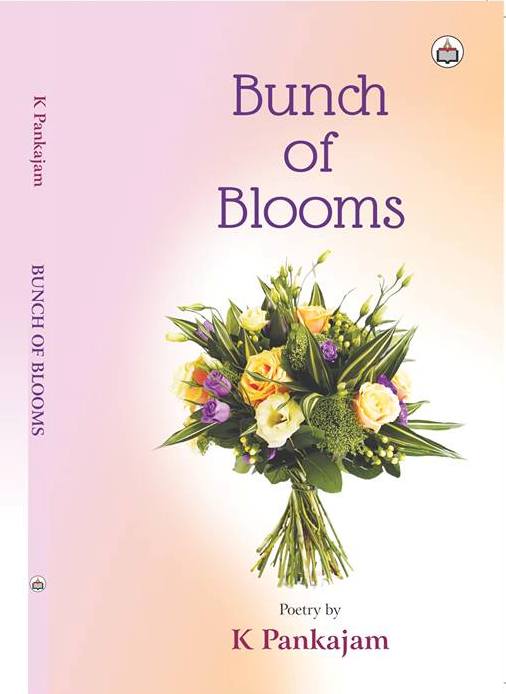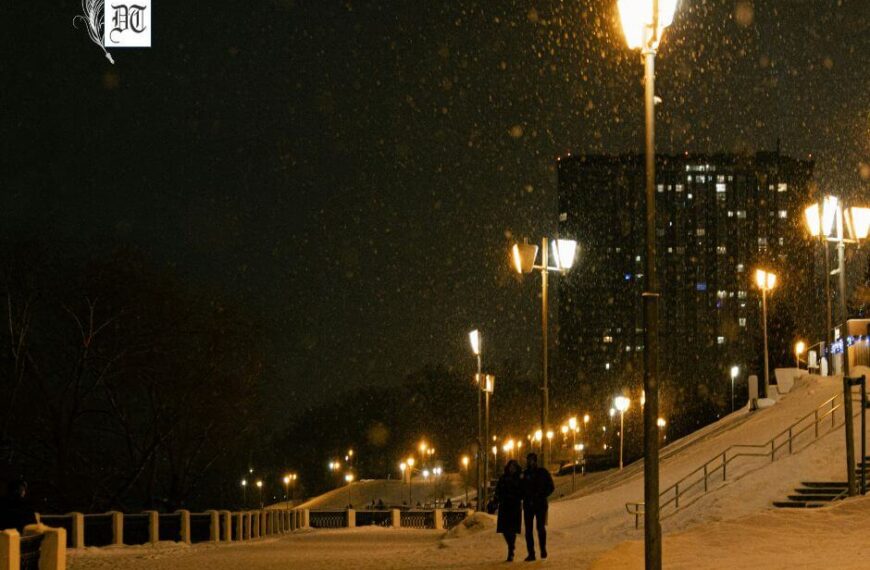Pankajam, a very prolific poet of high repute, standing in the garden of literature, with joy and pride, with her Bunch of Blooms, her eighth collection of poems tempts her readers to go through each enchanting part of the book. Divided into seven parts, Bunch of Blooms is a beautiful garland of her thoughts and feelings and emotions, manifested through various objects of nature, around humanity, love, peace, and bliss, and of course, the truth. Here’s a book review by Bhaskaranand, exclusively for Different Truths.
Bunch of Blooms (Poems)
Poet: K.Pankajam,
Publisher: Authors Press, New Delhi,
Year: 2017, Pages 110, Price Rs.295 $15
Flowers are lovely and beautiful; their fragrance is even more beautiful, soothing and pleasing but when they are kept in between the pages of the books, aroma of love and romance takes an ecstatic flight, on the wings of soaring imagination. It is heartening to see K. Pankajam, a very prolific poet of high repute, standing in the garden of literature, with joy and pride, with her Bunch of Blooms, her eighth collection of poems tempting her readers to go through each enchanting petal of the book. Divided into seven parts, Bunch of Blooms is a beautiful garland of her thoughts and feelings and emotions, manifested through various objects of nature, around humanity, love, peace, and bliss, and of course, the truth. In Preface, the poet herself reveals- ‘The thematic dissection is not fortuitous, but delicate…”, “Themes stem from my observations especially social concerns like lawlessness, the dismal tale of women etc.” Indeed, her poems mirror the mores of society and happenings around.
The first section, “Endless Endowments” contains twenty-four poems. Natural beauty and bounty are galore. The endowments of nature are really endless. As the statement below says, she sings the glory of mother earth for providing the basic needs to the people. It is a kind of her dedication to her that the poet highlights in her poetry. The very first poem “I know Why the Birds Sing” that alludes to Maya Angelou well-known poem, presents a vivid description of nature in various forms, with an optimistic note. Romantic imagination is at its best when she describes the ‘sky’, ‘circling clouds’, ‘mist’. There is a metaphoric touch as the singing birds ‘possess poets’ soul’. ‘Rivers’, ‘woods’ and seasonal diurnally are all well depicted. The grief of winter is gone with the advent of spring. The birds’ singing is indicative of all this. The poem is really refreshing, encouraging and a note of hope runs through between the lines. It also reminds us of Shelley’s oft-quoted line: “If winter comes, can spring be far behind?”
The poet appears to be keenly observant of natural activities around her. The beauty of sunrises and sunsets is wonderfully captured in “An Evening at Marina”. The poet is happy at heart when she hears:
…the sky sings the title song of the night
on the faded glory of the day
Elements of religiosity and spirituality are also galore in her poetry. Her “Holy Himalayas Beckon Me” is remarkable in this respect. She explores the meaning of life to understand the journey of life. She expresses:
A wish unbound
to make my while worth the voyage.
The poem is noteworthy for a brilliant use of transferred epithet and personification- ‘wicked winds’ and ‘meditating mountains’. The spiritual beauty of the mountains inspires her to demystify the intricate lore of existence.
The picturesque and enchanting beauty of nature is appealing to her. In most of her poems, her treatment of nature is excellent. While living in the lap of nature, she evolves a beautiful sense of appreciation for nature. Her description of nature is mind-blowing and imagistic. Her “The Rainbow” mirrors the celestial, cosmic beauty of nature in even more beautiful words. She describes “heavenly arc of colours’ as dancing on ‘the tall mountain peaks’. “Sun stretches out its tongue in awe/ swooned at the beauty of the bending lights’. Amid all this, the poet is full of praises for ‘the sacred skill’ of nature that seems to have built’ a bridge between sky and heaven’ to connect ‘men to the immortals’. The poet is ecstatic and speaks-“There is a lot to it than meets the eye, I feel/Happy, none can steal the pot of gold”. She expresses her desire:
Wish I too reside inside a bubble
the tiny mirror, through imperfect
light in the rain bathed sky, refract and reflect
show the universe heavenly charm,
make myriad hearts amuse at the symphony.
‘Azure sky’, ‘stunning moon’, ‘velvet desires’, ‘voluptuous pleasure’, ‘giggling stars’, ‘clusters of clouds’ (Spite ) etc show her extraordinary skill of using the power-packed diction that is enough to evoke the feelings in the readers.
The poet is reflective and introspective by nature. With the observation of nature, she makes her experiments with the ultimate reality. In her poems darkness finally gives the way to light. She is sad to see ‘trees sunk in sorrows stand stone-dead’. She reveals:
I furtively wear the heat of a poet
to tell the world, truth clothed in lies,
so far unsaid, muted, half-said or shouted
Despite the troubling tentacles of nights she never gives in and strengthens her zeal and patience even more and waits –
…for the sun to return to the horizon
to light up the sky and root out
the breeding inadequacies from my mind.
Fireflies, moths, flowers, rivers, peacocks, trees, pearls, storms etc help her in the articulation of her thoughts, ideas, and feelings. They carry the quintessential essence of her poetic creativity and expression in some way or the other. “Fireflies”, a symbolical poem, expresses her wonder at the well-kept world of insects and hence she stands and stares at the ‘sojourn’. The caravan of fireflies seems to be celebrating ’the carnival of light’ that at least ‘lights up ‘the mind of the poet. She writes:
I say goodbye to sleep,
join the marvel at the night
which is much more elegant
than what I imagined to be
or my eyes failed to see.
Similarly, the poem “Moths”, again an insect-centric poem, is quite optimistic in intent and shows the poet’s observation of insect world. Metaphorically, the moths or ants, gifted with ‘translucent wings’, celebrate ‘a single night’s glory’, ‘dancing around licking flames’. It is so didactic and in purpose. On the other hand, the poet’s “The Peacocks”, with ‘bright fluorescent colours’ impresses and inspires the reader with their beauty, though short-living. The poet rightly remarks:
Sense of aesthetic beauty evolved by birds
without wielding a sixth sense, I am at awe.
The flawless skill of creation, incredible,
exercised by the ubiquitous force in nature
to balance everything for survival of beings,
makes His presence felt, I bow before it.
The poet seems to be blessed with natural inwardness. ‘Sky’, ‘earth’, ‘creeping caterpillar’, ‘winged butterfly’ and other elements of nature contain something meaning for the people. In fact, they are ‘a symbol of resurrection’. Nature is the ’sign of love, joy, and hope’ the Biblical reference exhibits the poet’s sense of staunch religiosity. The budding process from ‘pollen’ to the fertilized ‘plants’ teach a great lesson of life, and reveals as to how the dream is translated into reality, ‘a sweet feast for tomorrow’. All the desires find culmination and fruition as they are carried ‘straight to the heaven for grant’. In this way, she finds the sparks of divinity in nature which is the best source of fulfillment of dreams and wishes of life. The beauty of nature adds ‘magic in life to relish’. The poetic vision of the poet is far-sighted as reflected in her poem “From Earth to the Sky.” Highly speaking of the glory of nature, she avers:
Nature’s art stirs my heart, I stand beguiled
watch your waltzing dance with fragile lace,
the oscillating wings wiggle like antennae
I crave for a look or stare that we share.
She repeatedly keeps glorifying nature weaving the poems in the praise of nature- “grandiose of the sky enthralls me’, stars at a distance know my desires’, ‘whooshing wind instills energy in me’, leaves ‘whisper in years’. She contemplatively listens ‘their doleful tales’. She opens her heart and says in “Tonight is Different”:
Smell of life lingering in the air invites me
The fragrance filters deep down to my sense.
Influence of Robert Frost on her poetic sensibility and expression can be witnessed in her poem “Pause for a While” which appeals to the readers to admire, appreciate and enjoy the charm and bounty of nature. “Give me one Minute” deals with the importance of time ‘to stay calm, connected and contended’. “The Tree of Sorrow” has a brilliant metaphor. “Pearls” again bespeaks of beauty and bounty of nature. In Wishes Immaculate” she expresses her wish to sustain and maintain the purity of nature:
Wish I return to my descendants intact
this pristine nature pure and unmolested
given to me by my ancestors on lease
with mountains, greens, rivers, songs of birds
honour the rules of nature for common survival
and fulfill the mission of my birth before I leave.
The second section “When the Sky Poured” comprises of only six poems. Here she talks about the fierce aspect of nature, as we see in the poem “We are One”. Leaving aside the beauteous part, she shows her awareness of natural calamities and disasters. She presents a realistic scene of the flood that causes a heavy toll on life. However, she firmly believes that nature connects and unites people and makes them realise to stand in solidarity with one another. She accepts:
Widespread ruins all over
yet the flood fortifies community bonds
humanity and solidarity upheld
brotherhood stood as one, we are one.
“Invisible Heroes” is an extension of “We are One” as both the poems are imbued with the same thought of getting united in midst of troubles for the sake of humanity. Motivational and inspirational, the poem highlights the philanthropic deeds of the ‘heroes’- selfless youths, army secular figures who cross the line of religions- for the rescue of the people in troubles. In times of devastations, ‘religious barriers’ are dismantled. The poet presents a secular picture of life- Muslims cleaning the temples, Hindus feeding in the mosques. She eulogies the duality of nature:
Nature was extreme to bestow rains
yet benign making people more generous.
Sure a lesson she left on future preparedness.
“The Mute Messengers” also carries ‘a message/ to fortify human bonds/ change the common convictions/ and fight natural calamities jointly’ as the flood is always revengeful; nature just tests our enduring perseverance and our psychosomatic might during troubled times.
“Hearts’ Affairs” is the third section dealing with the theme of love in the poems. Like nature, love is also a cornerstone of Pankajam’s poetry. She holds that trust and loyalty in love matter much more in life. Both trust and loyalty deepen with the passage of time and the bond is firmly formed. Love lasts longer but the lust has a quick pass. Nevertheless, both are essential for life to move on. In the poem “Love vs. Lust”, she boldly discloses:
It is like the egg and hen dispute
one overlaps the other, without doubt;
and at times exploring secret treasure trunks
together they blush, brace their ties.
Her perspective on lust is well articulated in another poem “Feasting on Lust”. She bespeaks of a beautiful yet eye-opening regular encounter a girl has to face while passing through the crowds of vulturous eyes of so-called Romeos. It is also a bitter comment on those looking at a passing or crossing girl with lascivious eyes. However, society is full of such good people also who offer ‘jacket’ of protection when’ she feels ‘the weight of a hundred eyes upon her.’
Her poetry shows love lighting not only ‘the candle of joy’ but also lightening ‘the sorrows of the old and ailing’. The feeling of love certainly brings back ‘tides of delight/ to the tots left to pathos and pain’. Hence, in ‘To Live is to Love”, she appeals to all:
love all and dream your morrow
for to live is to love, dream and laugh.
Her poem “Seeing the girl” exemplifies the magic and marvel of love in life. When true love happens, all sort of barriers caves in. Nothing matters more than love. True love is like ‘a translucent mirror’ reflecting ‘concealed joy’, ‘mutual adulations’, ‘censored passions’ guiding to the path of happiness and dream crooning the lyrics of life. It is the indelible ink of love that writes beautiful songs of life. Her “Soul and Sixth Sense”, a finest lyric, sums it up:
Love is born when body touches a body
Affection, when body touches mind
Worship when mind touches mind
Experience when mind touches soul
When mind realises beauty of the soul,
sixth sense arises as five can’t hold the bliss
True, “Life is a celebration” of love against hatred, hope against despair, success against failure, and of dreams and future.
Fourth section “My World” has poems about her poetic journey and the journey of the soul in her creative world; she begins it with her “Mother Tongue” that reminds one of Kamala Das’ proclamations in the poem “Introduction”. Like Das, the poet also declares:
Though in four tongues I read
speak in three and write in two
I dream in only one
the one in which my Mom prayed.
Pankajam’s viewpoint on poetry, poetic diction and words, and creative power and expression is praiseworthy. For instance, let’s see “Poetry”:
Poetry is the progeny
where less said is more
and the more one elaborates
the vaguer it becomes.
Words are always pregnant with meaning but unless they are expressed, they keep writing within. Words are the weapons for the creative people not only to fight against social injustice; but also to sustain human aspirations. In “My Words Long to Belong” she underlines the role and responsibility of a poet and objective of poetic writings:
My job is to cleanse and purify hearts
of yesteryears’ stagnated remnants
to instill fresh thoughts
never sees a break.
Wish I live in my own words
which long to belong,
and I pray;
pain, pen, and ponderings
don’t leave me and go.
“Prose and Poems” embodies a wonderful juxtaposition between the two. She divulges that poetry, an arrangement of special and appealing words, aims at enlightenment, ecstasy and emotional and intellectual fulfillment. Imagination lends glowing wings to it. In poetry, readers interpret the meaning therein, in their own way and evolve their own perspectives. Unlike a poem, the prose is ‘a one-dimensional journey/ with its wisdom’. The firmament of poetry is immense while that of prose is confined. In “My Poems Search for their Author”, she compares life to a poem showing the interconnection between the two. She says:
Life is a poem, both inter-reliant
every bit of it augments my life,
gives me a feeling, delightful,
one not different from the other.
Fifth section “Pristine Thoughts” is a marvellous collage of beautiful thoughts on various vicissitudes of life such as sleep disorders, stress, hurly-burly and sedentary lifestyles, disputes and exchange of heated words, fortune and misfortunes of a person, obstinacy, revenge, fear, hate, deceit, pride, causes and effects, gains and losses, terrorism, oppression, desperation, mysticism and exploration etc. Hinting at human predicament, she calls a man ‘a puzzle’:
… man is a puzzle
Who explores things in dreams
That are not earned in real life. (Man is a Puzzle)
However, she never forgets to thank the positive force for providing all that people need on the earth. Her heart is filled with gratitude for the fulfillment of existential needs, achievements, love, happiness, friendship, care and affection of her dear ones and most importantly peace and sleep. In “Gratitude” she expresses her thankfulness to nature:
I am full of gratitude
being a part of this wonderful world,
for peace and sleep
the health I bestowed with,
the delicacies I tasted,
infant laughs and flitting butterflies
sunshine, breeze and moonlight,
the flowers that entice me,
the ever enchanting nature,
to be able to enjoy melodies,
express my thoughts
gives me joy and wings to fly,
makes me feel blessed.
The sixth section “Tools of Sin” is a sensitive manifestation of her feminist viewpoint on the conditions of a woman in male-dominated society. The poems under this section are all woman-centric. She vehemently satirizes the misogynistic attitude of the people and tries to highlight the feminine power or her creative energy for sustaining the continuum of mankind and humanity. While ” The Misogynist Society” brings to the fore the unsecured life of woman or girl and hatred against ‘so-called ‘perpetrators’ carnal rule of sin’ in ‘ an apathetic society’ where there are ‘holes in the laws’, her” Caged Bird” poignantly throws light on the miserable plight of woman and advocates for her rights. She is an Indian version of Maya Angelou in the realistic portrayal of women’s travails. She pleads for the liberty of woman. “Aftermath – The Turmoil” is a heart-wrenching poem showing various atrocities meted out to woman- from physical and sexual assault to emotional and social alienation. Her ‘traumatic abuse’, ‘guilt and self-blame’, helplessness, pang, and pain are the aggravated ‘wounds’ that don’t heal’. Nevertheless, she ‘wants to regain lost shine’.
The vulnerability of woman is well depicted in another poem “She is Vulnerable”. Woman as a wife has to undergo a series of tortures. Here, man-woman relationship finds a discerning articulation. In the four-cornered wall of her home, she feels as if surrounded by ‘inferno of lust’, diurnally marred, muddled and maraud on the bed of sexual gratification. The poet has her say in this respect:
Desires when become undesirable
victims are victimized for life
or fall martyrs to ghosts of honour
thrusting blame on the frail ones
giving cover to the stronger breed
for acquittal from the carnal rule of sin
just because she is vulnerable.
The theme of man-woman relationship is further carries forward in “Is This Too Much to Ask for?” It is a retort given to a man who takes his wife for a commodity. She daringly declares:
Neither a merchant you are,
nor I, a commodity to be traded in
but your companion for life, in good or bad,
like fire for winter, breeze in spring;
conditioned from time immemorial
to be supportive, loving and caring.
She deserves respect and honour for her ‘inner universe’, chastity, loyalty and individuality. She also brings to his notice:
Hoping you would one day realise
without the sacred portal,
the divinity within women,
you wouldn’t have born on this earth
Last two poems of the section “Realize your Potential” and “Being a Woman” are the poets appeal to a woman to take pride in being born as a woman with ‘sweet shyness’ and ‘ blushing cheeks’ as she is a special prodigy of God. In the former poem she addresses with an exhortation:
Women, you are bestowed by nature
Too much of power in your thoughts
In the latter, she bugles with stronger force to foster ‘peace between us’ and equally joins together to complete the journey from life to death. She proclaims:
I want to be independent,
be on my own to boost my confidence,
not that I do not need you,
you can be the shade I embrace to be in the light
like the maple leaves to the butterflies in rain.
We ate different, but no discrimination
mutually reliant we are, none superior.
You and I are fed with the same milk
both at birth and after death too.
The concluding and seventh section- “Pocket Poems” has eleven three liners which give a finishing touch to the Bunch of Blooms.
In view of the themes, tone and tenor, texts, superstructure and textures of Bunch of Blooms, it must be said that K. Pankajam’s are sparkling thoughts that touch a reader’s heart for she has a flare of language, a bold weapon of and candid expression, sufficient enough to establish her as one of the strongest feminine voices of contemporary poetry writing in India. Lucid in expression and weighty in thought and meaning, her poetry deserves to be enjoyed to a greater extent.
©Bhaskaranand Jha Bhaskar
Photo sourced from the author
#BookCriticism #Poems #BunchOfBlooms #Poet #KPankajam #DifferentTruths





 By
By

 By
By
 By
By